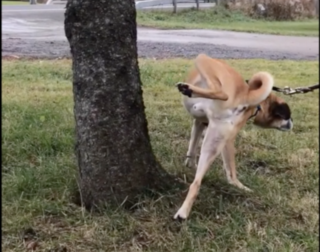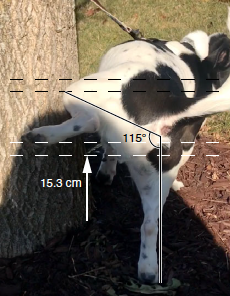Scent
When Small Dogs Pee, Are They Saying It's Really Not Me?
A new study suggests small male dogs may be sending out dishonest information.
Posted August 7, 2018
Does size matter? When I pee, it's really not me.
I'm always interested in research on all things "dog," and last week a popular essay published on Gizmodo called "Small Dogs Pee Higher to Lie About Their Size, New Study Concludes" caught my eye. Years ago some of my students and I were interested in whether or not small dogs tried to pee higher than large dogs and whether or not small wild coyotes tried to do the same, but we were unable to collect data that could answer this question. The Gizmodo essay, available online, summarized a new research essay by Betty McGuire and her colleagues published in the Journal of Zoology titled "Urine marking in male domestic dogs: honest or dishonest?" The title of the Gizmodo essay doesn't quite capture what the researchers concluded. Rather, they wrote, "Assuming body size is a proxy for competitive ability, small adult male dogs may place urine marks higher, relative to their own body size, than larger adult male dogs to exaggerate their competitive ability." (My emphasis) A good deal turns on the word "may," but this does not diminish the important new data the researchers produced in their seminal study. And, despite the title of the Gizmodo essay, we read, "new research found that smaller dogs lift their legs at an even higher angle than larger dogs, perhaps to make themselves appear larger." (My emphasis)

Dr. McGuire and her colleagues were interested in learning if urine marking may be honest or dishonest. In their first part of their study using video analyses, they "evaluated raised-leg angle and body size as predictors of urine mark height to determine if raised-leg angle could serve as a proxy for height of urine mark." It turned out that raised-leg angle was a good indicator of the height of urine marks, so using the angle of the raised leg to represent the height of a urine mark and body size as a proxy for a dog's competitive ability, the second part of their study tested the hypothesis that "urine marking is a dishonest signal in male dogs."

Previous research showed that small dogs urinate more than large dogs, perhaps indicating a preference for scent marking over direct interactions that could be risky. So, the researchers hypothesized that small male dogs would benefit more than large male dogs from exaggerating their size. Thus, they "predicted that small male dogs would exhibit larger raised-leg angles than large male dogs," the result of which would mean they were leaving urine marks higher then large dogs relative to body size.
Dr. McGuire and her colleague's study was well controlled.1 They also are well aware of the variables over which they didn't have control, including over-marking. In this case, when encountering urine deposited by a larger dog, smaller dogs would have to pee at least at the same height or higher. Along these lines, the researchers write, "Compared to large dogs, small dogs will encounter more marks that are higher in relation to their own body size for them to over mark; this could explain the negative relationship between body size and average raised-leg angle." I wonder if small dogs as well as others simply get more excited when they're over-marking, and this might result in peeing higher. I'm sure in future research they and others will control for over-marking (for more discussion about over-marking please see "Pissing Matches in Dogs: Territorial, Lots of Fun, or Both?").
Based on their data that showed (1) raised-leg angle was a significant predictor of the height of a urine mark and (2) a male dog’s body mass significantly predicted average raised leg angle, the researchers concluded, "Consistent with our prediction that small dogs would exhibit larger raised-leg angles than large dogs, we found a significant negative relationship between an adult male dog’s body size (using either body mass or height at withers) and average raised-leg angle."
What do the results of this study mean?
"I’ve often wondered if dogs who have to lift their heads to get a good or better whiff of pee know that a larger dog left it. Perhaps size does matter, after all." (Canine Confidential: Why Dogs Do What They Do)
I wrote the above quote many years ago after watching dogs for countless hours in a number of studies of scent marking and ground scratching. The results of Dr. McGuire and her colleagues' study shows that perhaps dogs do estimate size based on the height of a urine mark. All in all, they learned small male dogs tended to leave higher marks relative to body size than did larger male dogs. The researchers write, "even though height of urine mark does reflect size of signaler in part, small dogs seem to 'cheat' by using larger raised-leg angles to deposit higher urine marks, thereby exaggerating their size. It is possible that scent marking is honest in some contexts and dishonest in others; this may vary with identity of the signaler, type of information communicated, and property of the scent mark." It is known that small male dwarf mongooses place anogenital scent marks higher than expected given their size.
When dogs pee or mark they may be having conversations with one another and possibly be avoiding direct contact or conflict. Marking is a form of communication, and the presence of multiple marks by multiple animals may amount to a type of conversation. By marking, individual dogs are saying things like, "I'm bigger than you," “This is my place and you better stay out.” Or, “I’m in heat,” or “I was here,” or perhaps even, “I smell that you were here, and this is my way of saying I’m still around, too.” We really don’t know the extent of what dogs can communicate and understand through peeing or marking. My bet is that it’s far more than we think.
While we don’t yet know all they are likely able to detect, this appears to be an important part of how they get to know each other. Allowing dogs to take their time getting to know each other’s marks (prior to face-to-face interactions) might therefore help dogs have smoother introductions, giving them more social cues to guide their behaviors.
If small dogs are not as competitive as larger dogs, it would serve their purpose to exaggerate their body size and competitive abilities by peeing high and communication indirectly with other dogs, especially larger ones. Perhaps this helps them avoid direct conflict. In the research essay we read, "In contrast, large dogs have less incentive to avoid direct conflict due to their greater competitive abilities." Yes and no. Regardless of size, if an individual gets injured during an encounter this could have negative future consequences regardless of body size. One reason why ritualized threat signals have evolved in many diverse species is that they serve to decrease the likelihood of direct confrontations that might be injurious. Of course, it might be that smaller individuals have more to lose if they get injured, but we really don't know this because even a minor injury to a large animal can make them less competitive in different situations.
Dr. McGuire and her colleagues' study is very interesting and important. I look forward to learning more about what are small dogs thinking and what their intentions are when they decide to pee somewhere. Future studies also will need to focus on additional questions. For example, we still need to know how dogs respond to urine marks of different heights -- does the behavior of a dog differ when he (or she) sniffs a high mark rather than a low mark or when they have to stretch their necks to get a good whiff. Male and female giant pandas and dwarf mongooses spend more time investigating higher scent marks. It also would be useful to learn if there are gender differences among dogs.
In addition to leaving different scents that are contained in urine, there's also a visual component of the postures dogs use to deposit urine. For example, when male dogs use the raised-leg posture, other dogs can see what they're doing (for example, in the images above). Years ago, a woman told me that her male dog would often look around, lift one of his rear legs, and act as if he was peeing, but without actually peeing at all. Then, a few seconds later, he’d pee out a bucket’s worth. The woman also thought he only did this when other dogs were around. I’d seen this same pattern of behavior from time to time in dogs and wild coyotes but never paid much attention to it.
I decided to study this phenomenon and I learned that the presence of other dogs influenced whether dogs would actually pee or "fake it" -- they'd lift a leg but not pee significantly more often when they could be seen and then immediately pee afterwards when other dogs weren't around. They were not out of urine (Bekoff, Marc. “Scent-Marking by Free Ranging Domestic Dogs: Olfactory and Visual Components.” Biology of Behavior 4, 123–39, 1979). We called lifting a leg with out peeing "dry marking." Similar behavior has been observed among free-ranging dogs living outside of Rome, Italy by Simona Cafazzo and her colleagues. With respect to Dr. McGuire and her colleagues' study, It would be very interesting to know if small dogs exaggerate the height of their urine more when other dogs can see how high they're raising their leg and whether or not they're actually peeing when they can be seen.
What are small dogs doing and thinking? Do some dogs have a "little dog complex?"
Are small male dogs cheating or intending to send a dishonest message when they pee? Perhaps this is how they overcome their "little dog complex." We don't really know quite yet, but the data from Dr. McGuire's careful and detailed study suggest that this is a strong possibility. Dogs have the cognitive capacity to make these sorts of decisions and further research will surely tell us more about what they're thinking about as they pee here and there.
Please stand by for further discussion of peeing patterns displayed by domestic dogs. Who'd have thought that small dogs might intentionally make themselves "look" bigger by peeing at unexpected heights? There really is so much to learn about something dogs regularly do and all too often force us to change our own behavior, sometimes rather inconveniently, so they can do it in appropriate places.
Note
1"At least three factors influence the relationship between raised-leg angle and height of urine mark. First, size of dog affects absolute height of urine mark (i.e., no matter the raised-leg angle, a large dog would likely mark higher than a small dog). Second, height of urine mark depends on distance between dog and target (e.g., holding the raised-leg angle constant, dogs that are farther from the target will deposit urine at lower heights than dogs that are closer). We could not directly measure distance from planted hind-limb to target without disrupting marking behavior. We instead controlled for target shape, which partially affects how close dogs can stand (i.e., dogs can wrap their legs around poles and stand very near but, when marking walls, there must be space between the dog and the wall to accommodate the raised leg). We classified targets as cylinder-shaped (e.g., poles and tree trunks), wall-shaped (e.g., walls, fences, stacked pallets), and borders of tall grass (because grass borders are not solid, we separated this type of target from wall-shaped). Third, strength of urine stream affects height of urine mark (i.e., a weak stream will decrease in height before reaching the target). We could not practically and reliably measure this variable."




